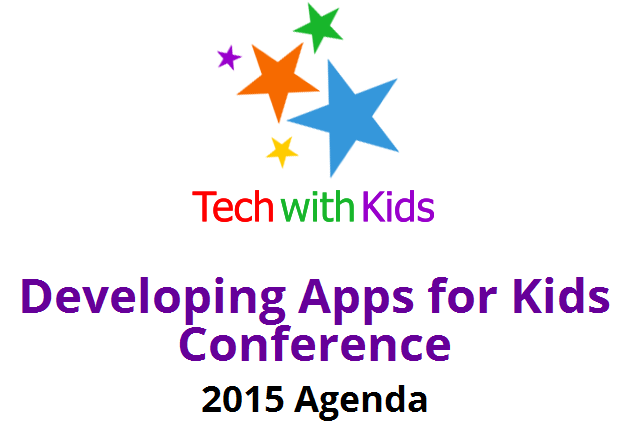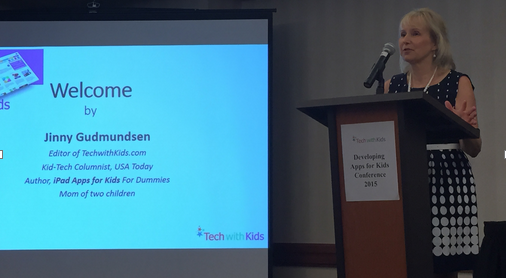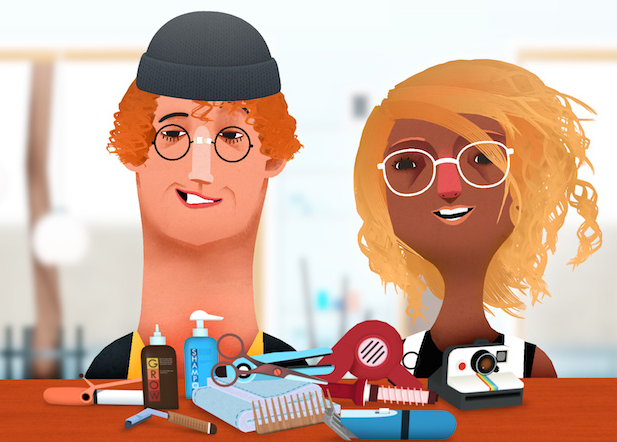 June 9, 2015 As a diehard infovore with a “what’s behind the media curtain” critical thinking lens, I’m fascinated by the scads of kids’ conferences I can’t afford and have no time to attend, usually gathering crumbs of media, education, technology data via hashtag to bring back to my little Twitter nest.
June 9, 2015 As a diehard infovore with a “what’s behind the media curtain” critical thinking lens, I’m fascinated by the scads of kids’ conferences I can’t afford and have no time to attend, usually gathering crumbs of media, education, technology data via hashtag to bring back to my little Twitter nest.
This week I chose to outreach like Cinderella in rags asking to go to the knowledge ball, and my wish was kindly granted by conference host Jinny Gudmundsen who writes the Kids Tech column for USA Today and edits TechWithKids.com.
Since I have no ‘skin in the game’ as a review site or kids app creator, and Shaping Youth has a “no products/perks/promos, “pass through” policy” (i.e. if a book lands in my lap, it gets donated to readers) I figured it was a harmless ‘ask’ since Tech with Kids was in my own SF backyard, and my caveat is always “I’ll definitely write something, but I won’t guarantee what.”
Curated Speakers and a “No Sponsors” Policy
 Tech with Kids piqued my interest early on with its “invitation only” speaker selection and a “no sponsors” dais of powerhouse panels.
Tech with Kids piqued my interest early on with its “invitation only” speaker selection and a “no sponsors” dais of powerhouse panels.
To me this signaled a refreshing alternative to the painfully familiar “pay for play” experts on many a stage, even though Jinny is a media maven, tech expert and journalist herself. It felt like the intention of the curation was less ‘industry hype’ and more knowledge sharing, which set a mood of a fireside chat to spark deeper insights, even if it meant setting a few ablaze.
Admittedly, I helped light the match on a few of those fires with unrestrained candor, asking questions about the objectivity of app review sites and critic’s clout, like:
“Who’s researching the researchers? Who’s reviewing the reviewers? What constitutes a critic and who gets to decide what’s educational when there are vested interests and industry tethers?”
In the Venn Diagram of the media galaxy it seems players are orbiting the same sphere of influence when industry nonprofits, education technology, research and digital journalism share so many of the same circles and tethers to funding lifelines…
Where’s the media literacy to shade in the overlapping areas?
Speaking of shady, one of the volatile conversations that lit up the room was the infamous ‘pay for play’ dynamics surfacing among some review outlets who grant ‘expedited reviews’ with a rate card. Ahem. Mind boggling, and evidently common in certain spheres…
Paying for App Reviews Constitutes Contaminated Content
Needless to say, that’s a journalistic ethical breach that I’d hope mainstream media wouldn’t copy, but with ‘native advertising’ and blurred lines of “advertorial” lately, (looking at you, Forbes) the candid comments at the conference have vaulted me into media literacy recon/crowdsourcing mode to start gathering data with firstperson storytelling to add to this three year old data via AppyNation’s ‘Hall of Infamy’ list.
Do leave a note in the comments if you’d like to share your own experience. (Also noticed in the always insightful #DustorMagic app camp recently they were discussing this same topic at about the 17:20 mark in this video!)
Aside from applying critical thinking to all phases of app development, the engagement and energy of participating in “developing apps for kids” would not normally be in my wheelhouse, but this conference marked a shift for me…
Prevention vs mop up is inspiring!
All too often those of us in media literacy are tasked with deconstructing messages already out there to teach critical thinking in ‘fix it’ mode, giving students a lens to purposefully analyze products and portrayals AFTER the media and marketing is produced. I’d FAR prefer to see a more productive shift applying best practices at the development stage like this, on the FRONT end vs the back end of the industry pipeline when misfires are already magnified (and manufactured!)
Just imagine if the ‘powers that be’ at bigwig kids industry events like Toy Fair heard concerns and parental pushback BEFORE they introduced entire genres of hyper-sexualization and body image toxicity, or BEFORE they gave Merida a makeover in the sparkle silo promoting vapid values to girls about beauty and worth. Same goes for apps and new categories of wearables, sensors, tracking devices and interactive surveillance toys that fall into the “just because you CAN doesn’t mean you SHOULD” line of tech toy/app reasoning.
Wouldn’t it make more sense to receive “majority messages” loud and clear at the development stage instead of final phase of bringing a product to market?
Let’s seed strategic thought with the producers, developers, and creators at the onset to make positive choices early on, from diversity and gender portrayal to plugging privacy policies into the DNA of apps to address datamining, in-app purchases, and other parenting concerns.
Let’s talk about the neuroscience of designing toys, goods and services to leverage brain plasticity, tactile art and exploration, gross motor skills, imaginative open ended play, empathy and social emotional learning fun.
Let’s bake in the notion of ‘balance’ to reinforce nature, outdoor discovery, and collaborative group play rather than stoke the polarized debates of “screenstavers vs vidiots” or stereotyped tropes of solo-centric childhood and a nation of narcissistic nerds.
Building on best practices instead of mopping up messes makes good sense to me from a wellness/public health/behavioral perspective…Create safe, fun spaces where kids can be kids…to play online AND off.
 I’ll be writing about various topics and take aways from the conference all week. The panel about creating apps and media with diverse characters (race, gender, personality, inclusiveness, and good ol’ quirky fun) was initially my first choice to profile, but as they say in startup land, ‘be prepared to pivot’…so I am.
I’ll be writing about various topics and take aways from the conference all week. The panel about creating apps and media with diverse characters (race, gender, personality, inclusiveness, and good ol’ quirky fun) was initially my first choice to profile, but as they say in startup land, ‘be prepared to pivot’…so I am.
Truth is, Tech With Kids presenter and Guardian reporter Stuart Dredge wrote a wonderful quote-laden recap “Gender Depictions Tend to Be Very Stereotyped” surfacing only a few hours after the conference ended so I’ve ditched my prior piece and shifted my focus toward other aspects of “getting it right” for kids developmentally, and digitally…
Don’t miss his piece on how a growing number of developers (including Toca Boca, shown above) are now thinking hard about how they present gender, race and socio-economic differences, bumping up against the proliferation of stereotypes with increased consciousness and a hands-on ‘market correction’ laced with personal trial and error. I’ve written a lot about this positive progress in upending gender stereotypes lately, and even created a video for a talk recently on both the problem run rampant (Part One) and some solution-based companies slowly taking hold (Part Two)
As media producers and consumers, we have to keep an eye on what we’re perpetuating. Those at Tech with Kids should all be asking themselves:
“What kind of world do we want?”
Then design to it.
For more: See the agenda and speakers at Tech with Kids…(and recaps via hashtag #techwkids)
Industry Notes: Editorial Panel/App Pragmatics: Jinny Gudmundsen & Stuart Dredge
For Apps Developers Pitching Press: ALWAYS make it easy: Clear, concise title (helps with discovery) link directly to App Store (all platforms iTunes, Amazon, Google Play, Microsoft) include quick clip/video via link and/or screenshots, don’t plead or pester it’s unbecoming, include an area on your site that’s a ‘press center’ to subscribe for updates/images, new releases, etc. Include any “3rd party validation” seals/endorsements (e.g. Moms with Apps)
Allow plenty of lead time, check/ask about regular editorial calendars where apps are featured prominently as resource roundups, like summer slide, back to school, playful learning apps, and the ever popular “listicle” format which usually includes a Top 10, Top 20, Best Of…etc.
Additional insight from Jinny about columns being carved up into word count chunks and parceled into portions with aligned media, for example the USA Today Weekender edition can mean the slice and dice of Kids Tech column into syndication/alliances with 82 Gannett newspapers; problematic for link breakage. Flipside? Exposure. Learn “who’s on the team” as small town newspapers may run more robust coverage etc. Shelf life of being “featured” on app store is two weeks or so, have new stories, living/breathing updatable content
App Design Tips: Colorful descriptor icons, understand global markets and localize (for example changing the decimal points in app prices results in 2X sales bumps from .99 in US to .00 in Japan; full translation can mean 6X bump in sales per Shazia Makhdumi, Global Head of Educational Apps/Games/Partnerships at Google Play)
“Breaking News” in Kids Apps
Metamorphabet just won an Apple Design Award!
Is Jinny prescient? The app she mentioned at the conference as being ‘visually arresting’ in its playfulness and fun just won the Apple Design Award today at the Worldwide Developers Conference! #WWDC15
Designed by a one-person studio, Metamorphabet ‘won the gold’…Here’s Jinny’s Kid Tech Metamorphabet review written earlier in the year. Clearly she knows her stuff. Fun!









Speak Your Mind